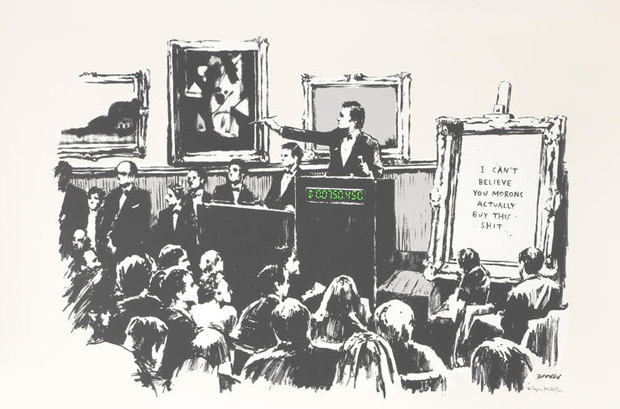
Alain de Botton on Banksy and buying art
The public intellectual and Phaidon author believes galleries should help their clients to lead better lives
Alain de Botton and John Armstrong's copiously illustrated book, Art As Therapy, offers a fresh and thoughtful perspective on some familiar artists. The authors suggest ways in which works of art can, if read in a certain way, be used as a tool, as to achieve, among other things, spiritual balance and reconciliation in our own lives.
The authors don't just consider the works themselves, however - they look at every aspect of our relationship with art, including the business of art dealership. And so, for the chapter How Should Art Be Bought And Sold?, they use as illustration British graffiti artist Banksy's pointedly titled I Can't Believe You Morons Actually Buy This Shit (2006), which depicts an auction house in which a portrait featuring these words is going under the hammer. The authors offer their own, politer subtitle to the work; "A wise purchase for someone susceptible to hype". They decry the prevailing values of art dealers and private galleries, which are primarily those of salesmanship. "Galleries seek to create an atmosphere that combines exclusivity and the sense of being at the cutting edge; that is, they build on our anxieties about being an outsider or old-fashioned."

Building on the satirical prod provided by Banksy, the authors suggest an alternative, altogether more serious role for the art dealer - "to connect purchasers with the art they need". This would involve identifying the spiritual wants of a client, rather than merely pandering to their desire for prestige. "Galleries ...could set out to help clients living better lives by selling them the art they need for the sake of their inner selves." De Botton and Armstrong acknowledge that this would strike many as a far-fetched process for buying and selling art nowadays - but that is merely because as a society hypnotised by aura of the highly monetised modern art world, "we have the wrong picture of what art is".
If you're intrigued by these ideas, you'll find plenty more in Art as Therapy. Why not buy it from the people who made it here.